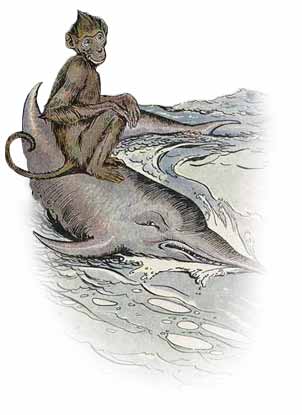The Monkey and the Dolphin 猴子和海豚 (精美插图) 双语 拼音注音 伊索寓言
标签:伊索寓言 儿童故事集 中英对照翻译 双语故事 拼音注音
Last Update 最后更新: 2022-01-12

The Monkey and the Dolphin (English)
Total Words: 241
It happened once upon a time that a certain Greek ship bound for Athens was wrecked off the coast close to Piraeus, the port of Athens. Had it not been for the Dolphins, who at that time were very friendly toward mankind and especially toward Athenians, all would have perished. But the Dolphins took the shipwrecked people on their backs and swam with them to shore.
Now it was the custom among the Greeks to take their pet monkeys and dogs with them whenever they went on a voyage. So when one of the Dolphins saw a Monkey struggling in the water, he thought it was a man, and made the Monkey climb up on his back. Then off he swam with him toward the shore.
The Monkey sat up, grave and dignified, on the Dolphin's back.
"You are a citizen of illustrious Athens, are you not?" asked the Dolphin politely.
"Yes," answered the Monkey, proudly. "My family is one of the noblest in the city."
"Indeed," said the Dolphin. "Then of course you often visit Piraeus."
"Yes, yes," replied the Monkey. "Indeed, I do. I am with him constantly. Piraeus is my very best friend."
This answer took the Dolphin by surprise, and, turning his head, he now saw what it was he was carrying. Without more ado, he dived and left the foolish Monkey to take care of himself, while he swam off in search of some human being to save.
Moral: One falsehood leads to another.
猴子和海豚 (中文翻译 拼音注音)
在很久以前,有一艘去往雅典的希腊船在雅典的比雷埃夫斯港附近的海岸处沉没了。如果没有那些亲近人类,尤其亲近雅典人的海豚出手相助,船上的人早就没命了。海豚驮着失事船只上的人游向岸边。
那时,希腊人习惯在外旅行时带上他们的宠物猴子和狗。因此当一只海豚看见一只猴子在水中挣扎的时候,他以为那只猴子是人,于是让猴子爬到他的背上。然后他带着猴子游向岸边。
挺直腰板坐在海豚背上的猴子摆出一副庄严的神态。
“您想必是来自著名的雅典城的市民吧?”海豚礼貌地问道。
“没错,”猴子自豪地回答道。“我的家族是城中最德高望重的名门之一。”
“那不用说,”海豚继续道。“您一定经常来探访比雷埃夫斯(港)吧。”
“是啊,是啊,”猴子回答道。“确实如此。我经常跟他在一起。比雷埃夫斯是我最好的朋友。”
海豚对猴子的答案感到很惊诧,他回过头来一看,顿时明白自己身上载着的是何方神圣。于是他二话不说就潜回海里,留下猴子照顾自己,与此同时海豚继续游到别处救人。
Relevant Fables 相关寓言故事
- 伊索寓言:The Monkey and the Camel abc
- 伊索寓言:The Monkey and the Cat 猴子和猫
- 伊索寓言:The Fox and the Monkey 狐狸和猴子
About 关于
The Aesop Fables for Children 伊索寓言儿童故事全集 (图文英汉双语版) (this work), the english fables originally from The Aesop for Children: with Pictures by Milo Winter published by Rand, McNally & Co in 1919. Some of pictures come from Library of Congress. This work is considered to be in the public domain in the United States. The Aesop Fables for Children contains the text of selected fables, color pictures, video, and interactive animations, and will be enjoyed by readers of any age.
The Aesop Fables for Children are a collection of stories designed to teach moral lessons credited to Aesop, a Greek slave and story-teller thought to have lived between 620 and 560 BCE.
Aesop's fables are some of the most well known in the world and have been translated in multiple languages and become popular in dozens of cultures through the course of five centuries. They have been told and retold in a variety of media, from oral tradition to written storybooks to stage, film and animated cartoon versions—even in architecture. This page include translation to Simplified Chinese.
伊索寓言是一部世界上最早的寓言故事集,是世界文学史上流传最广的寓言故事之一。 本文包含伊索寓言故事英文原文和简体中文翻译(中英双语)。




